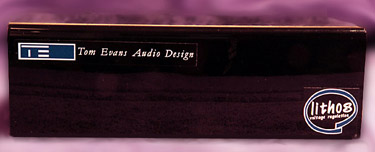-edible zone-
Review: Tom Evans Micro-Groove-Plus
Date: 2/25/2003
Author: Steve Clarke
Model: Micro-Groove-Plus
Category: Phono
Stage
Suggested Retail Price: $1800.00
Description: a class-A
solid state voltage regulated stereo phono stage with separate power
supply
Dimensions: 7.875 x 2.75 x 4.92 inches
Weight: 1.1 lbs
Manufacturer: Tom Evans Audio Design
Tel/Fax. +44 (0) 1443-833570
E-mail: bill.pilcher@ex-cell.co.uk
Manufacturer URL:
http://www.besthifiintheworld.com/
Model Picture:

The manufacturer describes this unit as follows:
".........
The Micro-Groove utilizes the same basic circuit topology as its
predecessor i.e. A low noise Class A front end device providing gain
feeding a passive equalization circuit, followed by a phase error
correction circuit with an active DC servo around the correction stage
to roll off sub-sonics and DC offset."
A stand-out feature:
The inside business of The Micro-Grove, The Micro-Groove-Plus, and
The Groove is housed in a non-metallic, acrylic case. This design
feature eliminates eddy currents that would otherwise spread in the
circuit board. The Tom Evans website says: "The acrylic case provides an
environment where minute changes in voltage created by the cartridge are
preserved and simplified with minimal corruption. The screening of the
circuit and power supply is implemented internally using ground planes
and earthed copper sheet." The site also acknowledged that one
particular metal that could also provide the above qualities would be
copper.
The Micro-Groove-'Plus' designation indicates this model
to be a Micro-Groove with the added benefit of the 'Lithos' voltage
regulator. The regulator, another Tom Evans design, greatly enhances the
unit's "quality of transient response time and noise figures of the
voltage rails." The Micro-Groove can be upgraded to The
Micro-Groove-Plus specification by the Tom Evans Design facility in
England for approximately 300 Pounds + shipping costs.
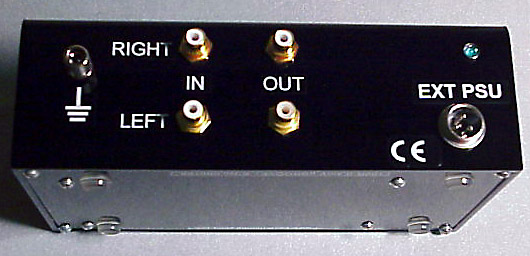
There are no user settings for cartridge ohm loadings or gain settings. This must be done at the Tom Evans Design facility. The normal procedure is for the customer to let the sales team know which cartridge will be used and the unit is built to suit. "But...hey wait a minute", you say; "what if I change cartridges downstream?". Answer: Contact your dealer, or send it back to Tom Evans Design and Tom Evans will re-set it for your new cartridge.
Associated audio gear:
For this audition I was supplied with the Tom Evans Groove
Tube interconnect.
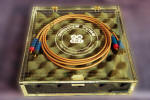 These cables were used to feed the signal from The Micro-Groove-Plus
....
These cables were used to feed the signal from The Micro-Groove-Plus
....
...into the Classe' CAP 151 integrated stereo amplifier.
 Speakers in use are NHT 2.9 4-way, floor standing towers.
Speakers in use are NHT 2.9 4-way, floor standing towers.
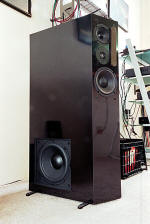 The front end device is a Teres Model 135 non-suspended turntable with a
Shelter-501 type-2 moving coil cartridge.
The front end device is a Teres Model 135 non-suspended turntable with a
Shelter-501 type-2 moving coil cartridge.

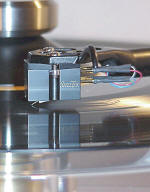 Mounted to the Teres is an Expressimo RB250 tonearm. This tonearm is
equipped with a Cardas wire set that features one piece construction
from the headshell leads out to the RCA's. The tonearm also features
full structural modifications by Expressimo Audio to this Rega RB 250
substantially enhancing it's tracking and sonic output.
Mounted to the Teres is an Expressimo RB250 tonearm. This tonearm is
equipped with a Cardas wire set that features one piece construction
from the headshell leads out to the RCA's. The tonearm also features
full structural modifications by Expressimo Audio to this Rega RB 250
substantially enhancing it's tracking and sonic output.
Break in, burn in time.
The Micro-Groove-Plus does require a
significant break in period. The user manual states : " Warm up and burn
in takes up to three weeks with the largest changes occurring in the
first 72 hours of use." Tom Evans also wants the Pre-amp to be left
powered up at all times. If unplugged, it will take a few hours for the
unit to reach it's full potential again. This review sample is a
demonstration unit with enough hours on it for me not to worry much
about burn-in. Nevertheless, The unit did require being powered up
constantly and did take several days for the Lithos regulator to reach
optimum temperature and then stabilize. It's fussy, that way. When not
fully stabilized, the Tom Evans Micro-Groove-Plus sounded a bit bright
in the mid and upper frequencies and then light and bass shy in the
lower frequencies. This improved over the course of a few days as the
sound gradually became more natural and full bodied.
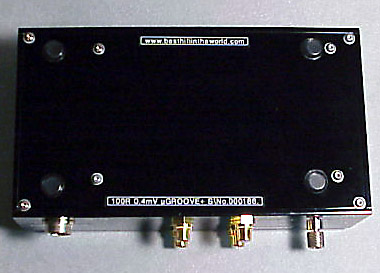
Listening impressions:
This
phono stage does some truly satisfying justice to the Classic Records
180gram re-issue of the Led Zeppelin II LP. Faint nuance and details are
brought into a high resolution focus, all the while lending deep
reserves of energy and drive to the dynamic transitional passages the
album is chock full of. Speaking of transitional passages, most Led Zep
fans will mention "Ramble On" as one exceptional track that show-cases
the group's dynamic capabilities in the art of transition. It's the
contrast between the cozy acoustic guitar and gentle vocal getting
aroused into a full-on screaming hard rock number carried up on the back
of Bonham's energetic percussion licks. The harmonica in "Bring It On
Home" is shockingly real and at times in the room breathing air, blowing
chords and flying around the width boundaries of the soundstage. Stereo
effects like these are done to an even greater effect in "Whole Lotta'
Love" with it's stunning percussion solo, numerous ringing cymbals, some
which are impossibly soft yet focussed, playing hide and seek in the
three dimensions of the soundstage. Finally, the last energetic
transition happens in "Bring it on Home". With a pair of rim shots,
Bonham launches another high volume, full bore wailing screaming hard
rock finale. I defy any Led Zeppelin fan to hear this album through the
Tom Evans phono stage and keep their feet still. I sure can't. Tom Evans
rocks...!
The Tom Evans Micro-Groove-Plus displays it's music
against a super silent background. It also displays ultra quick attack
transients. Transients are the leading edge of a note. Phono stages
capable of handling transients faster will create the sense of space and
air around instruments. Then there are the goose bumps. One of my
favorite goose bump tests is the opening track on Moody Blues "In Search
of the Lost Chord". The Micro-Groove-Plus does manage to lift the hairs
on the back of my neck when a single synthetic tone starting out as a
bass note, climbs in pitch up from the depths to the midrange then into
the upper frequency ranges and the limits of human hearing, and finally,
it disappears beyond. Smooth and seamless. This can be anticipated. You
wait for it, look for it, and yet the goose bumps happen every time.
This test also works with another phono stage I have, but it worked very
nicely with the Tom Evans.
Recorded classical music played by a
full orchestra presents a challenge to an audio system's ability to give
focus to individual instruments among the dense wall of sound coming out
of an orchestra. Admittedly, this kind of program material might be what
separates the truly great high end gear from the merely good. And I know
the particular group of components I'm listening to doesn't belong in
the "truly great" category. More like the "kinda good" category but it's
still high end by my reckoning. Nevertheless, I've fed the
Micro-Groove-Plus a large selection of the classics from J. S. Bach to
Beethoven, Berlioz and then Chopin, Debussy, Dvorak, Handel and Mozart.
But wait, there's Prokofiev, Rachmaninoff, Ravel and Strauss, (Johan and
Richard), then Tchaikovsky and finally, Vivaldi. And that's not counting
all the ancient music and the lesser-known's from the renaissance and
baroque periods. In this menu of program material, the Tom Evans does
indeed nicely lend focus to the softer details that exist in the
sometimes convoluted mix. Dynamics, when present in the record, are
explosive and delivered with solid, satisfying force. The very high
violin solo in Rimsky Korsakoff's Scheherezade, (London SPC 21005,
Stokowski conducting, Erich Gruenberg on violin), explores the upper
frequencies without any apparent roll off or grain. The violin high
notes are simply clean, strong without piercing my ear drums and
presented in a sweetness of tone consistent with the instrument playing
in a concert hall. Other differences between, say, a Tympani or a bass
drum are obvious and easy to recognize. There is no muddiness in the
lower regions. Timbre and texture of the lower frequencies are fully
developed and allow the listener to know if it's a baritone horn or a
slide trombone playing low. Assuming the listener knows the difference
in the first place...;-)
Jazz. A small selection of jazz albums
were used in the audition. Miles Davis, Herbie Hancock, Les McCann,
Donald Fagen, Michael Franks, Pat Matheny, BS&T. Kind of a diverse group
and crossing over different genre's of jazz. And it's a small group
because that's all I've got in jazz. So how was the Tom Evans at playing
jazz, you ask...? Well the answer is just fine, thank you. The tight
textured bass, transparent mids and highs coupled with fast transients
combines to make a recipe of very good jazz.
For audio hardware
evaluation, I used to find myself wanting to gather together a small
group of records I like and consider in some way definitive. Then, I
would compare the different pieces of audio gear by playing these same
records and evaluating what the given piece of gear could do with that
handful of albums. On the flip side, it has been pointed out to me that
there might be a better method than this. The idea is that the preferred
goal for an audio system is to achieve the most accurate playback of a
recording that is possible. If this is the case, it must then be allowed
that the quality and diversity of recordings out there is very wide.
Even the same record album will have a somewhat different character when
making comparisons between the early and later pressings. Considering
all this, the ideal piece of gear should display the greatest diversity
of sound across a large list of recordings. A lesser piece of gear will
tend to have a 'signature sound' and be more 'identifiable' across that
same large group of recordings. I.E. playing the same sounding bass
notes with similar force in all rock albums, or maybe a particular cozy
warmth in the midrange that always shows up, etc. The more accurate
piece of gear will tend to tell you what's on a given record whether you
like that sound or not. It should tell you the truth. Does that make
sense..? Can you handle the truth or can't you..? Where is Jack
Nicholson when you need him..?
The Tom Evans gets pretty close
to telling the truth, I suspect. In addition to playing the Classic
Records re-issue of Led Zeppelin II, I fed a large list of pop and
classic rock through this phono stage. On a number of albums I initially
thought the Tom Evans to be just a cup short of bass and a few ounces
lacking in slam. Over the course of several days I noticed some
recordings to be lacking in bass and others to have substantially more.
There was always texture and timber and minute detail. Elton John. First
album, "Take Me To the Pilot". This is one of my favorites for it's
layered progression into a glorious, raucous gospel rock and with a very
deep, extended bass line. The Tom Evans closely matched the force
delivered in bass to the cd I have of the same. That told me I wasn't
losing any bass due to the phono stage. And of course the record
completely outclasses the cd in terms of aliveness and ambience.
Actually the highs on the cd seem just a little bit hot and harsh.
To sum:
The Tom Evans displays music truthfully with tight
textured bass, pristine transparent midrange and high frequencies. No
roll-off. No grain. It's not overly analytical. It has a very quiet
background. It is highly detailed and it brings music alive with it's
ultra-fast transient response. It is also revealing and will tell you
truthfully what is on your records. What more can anybody ask...? Hey it
rocks with the best of them and then turns around and plays blissful,
beautiful classical music.
Other Comparisons:
I was able
to do some A to B comparisons between the Tom Evans and the Wright
WPP100C phono preamp. The Wright is reviewed elsewhere at this sight and
begs comparison to more expensive competitors. Below are some of my
observations.
Overall Character: The Wright is a tubed phono
stage and sounds it. The Tom Evans is solid state and doesn't sound
tubed. What does that mean...? I mean to say there is a pronounced
difference in tonal character between the two phono stages. I tend to
think of the Tom Evans as having a transparent tonal delivery, but when
compared to the Wright, the Tom Evans is a clean 'white' sound while the
Wright has a 'cool' tonality across it's entire frequency range. Both
sound undistorted. Solid state versus tubes, you call it.
Bass
delivery: The Wright has louder bass, but is it real and part of the
record, or is it an artifact of the electronics in use....? Bass is
textured and detailed with the Wright but is it just a bit 'looser' than
the Tom Evans...? I haven't decided yet. The Tom Evans could be
described as having 'tight' but extended bass. It goes way down deep but
with less slam and impact than does the Wright.
Aliveness,
ambience, detail, etc.: They're both similar in the ability to evoke
ambiant sensations. Goose bumps if you will. Both serve up loads of
impossibly fine details as a part of the whole sonic picture. Both
handle dynamic passages with ease and aplomb. They're both 'fast' in
their ability to display the leading edge of notes, then the body and
tail.
Soundstage, imaging: In my system, the Wright and Tom
Evans offer up a similar width of soundstage but with the Wright tending
to be closer toward the listener and the Tom Evans further back toward
the speaker baffles and behind. Both produced entertaining and
spectacular phantom images. Both could cause the speakers to 'disappear'
behind the music.
Musical preferences: The Wright worked better
for me at the few jazz albums I have. It must be the 'cool' tonality.
The Tom Evans get's a slight edge at playing Led Zeppelin. It might be
that the Tom Evans is a bit better in Pace Rhythm and Tempo, although I
think both stages have good PRAT. The Wright gives good Led Zeppelin,
make no mistake but maybe my feet weren't quite as quick to fly up off
the earth. In classical it might be a tie. I liked the way both
presented the various classical records I played and can't make up my
mind which I prefer. Distinctly different, yet both are quite enjoyable.
Which one is telling the truth..?..: I suspect the Tom Evans is
closer to revealing the actual content of what's on my records. But
which one do I enjoy hearing more....? Which one will offer the most
'long term' satisfaction...? That's a tough call, I gotta think about
this one. It's too bad all of life's choices can't be this much fun for
everybody.
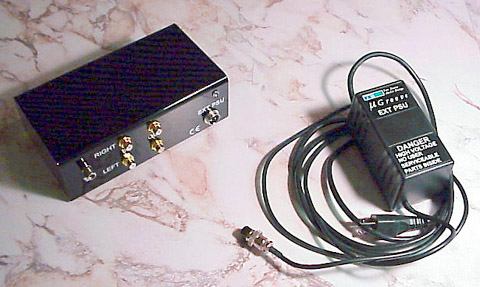
Credits:
This review sample and interconnect cables were graciously supplied
by:
Larry Cloetta
Avantgarde Audio
South Walk
Squaw Creek
Road
Jackson Hole, Wyoming 83001 USA
ph: 307-734-9149
email:
lcloetta@wyoming.com
An authorized dealer for Tom Evans products
